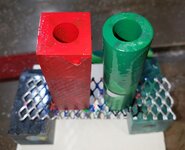egnald
Member
Greetings from Nebraska. My latest project (a Rhinoplastic rainbow of cigar pens) has not been going very well, I back painted my blanks, but still wound up with areas where the tube shows through. I must have somehow scraped the paint away when I was gluing the tubes in - very frustrating.
I have spare tube sets and another batch of blanks on order already. This morning, I found the specialty drill bits for plastics on McMaster-Carr available in inch, metric, letter, and wire gauge sizes. I ordered an "X" (0.397", about 3 thousandths over the 10mm, 0.3937) and a "Y" (0.404", about 10 thousandths over) so I can have a little more clearance to accommodate the paint thickness. I understand that typical paint thicknesses are on the order of 5 thousandths, so if I both back paint and paint the tubes I should still wind up with a snug fit.
Do any of you use over-sized drill bits for working with plastics when back and tube painting? Am I on the right path or are there alternatives that might work just as good as (or better than) oversized drills?
Regards,
Dave (egnald)
I have spare tube sets and another batch of blanks on order already. This morning, I found the specialty drill bits for plastics on McMaster-Carr available in inch, metric, letter, and wire gauge sizes. I ordered an "X" (0.397", about 3 thousandths over the 10mm, 0.3937) and a "Y" (0.404", about 10 thousandths over) so I can have a little more clearance to accommodate the paint thickness. I understand that typical paint thicknesses are on the order of 5 thousandths, so if I both back paint and paint the tubes I should still wind up with a snug fit.
Do any of you use over-sized drill bits for working with plastics when back and tube painting? Am I on the right path or are there alternatives that might work just as good as (or better than) oversized drills?
Regards,
Dave (egnald)

